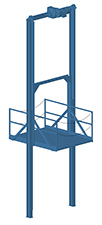Mezzanine Access Lifts, Vertical Reciprocating Conveyors, and Scissor Lifts
We offer a number of ways to safely access your mezzanine, work platform, or rooftop.
Which Mezzanine Access Lift Fits Your Application?
1. Rider Scissors Lifts:
a) Advantages: This solution allows material handling personnel to ride with materials between the various levels. As long as the lift is constructed to comply with ANSI: MH29.1:2012, it will comply with the 2015 International Building Code, it is exempt from local elevator codes and does not require elevator installers. The lift must be controlled by the operator on the platform.
b) Disadvantages: Travels are restricted to no more than 18 feet. Lowered heights are relatively high and require pits. These lifts are fully assembled at the factory and relatively heavy, therefore installation sites with tight or limited access may be problematic.
2. Non Rider Scissors Lifts:
a) Advantages: These units have the same advantages as the rider units except the controls are fixed externally at each elevation and may be of the call/send variety. Platform sizes may be smaller than the rider units.
b) Disadvantages: The minimum platform sizes are dictated by the size of the leg assembly beneath them and may be larger than desired. Speed is generally limited to 8 to 12 fpm for most scissors lifts.
3. Vertical Reciprocating Conveyors (VRC’s):
a) Advantages: These devices offer a wider variety of platform sizes, with standard speeds of 16 to 30 fpm and vertical travels up to 100 feet. These units are more easily configured to custom configurations. The units are assembled on site, so access to tight locations are less of a limiting factor.
b) Disadvantages: In some jurisdictions the units must be installed by elevator installers and must be inspected by elevator inspectors. In all cases, on site assembly is more time consuming and expensive than scissors lift installations. Riders are never allowed on these units.
4. Package Lifts:
a) Advantages: These are smaller preassembled VRC’s designed for movement of packages smaller than pallet size. They may be single piece tip up or two or three piece stackable units which means faster simpler installation. Standard vertical
speeds are 30 fpm.
b) Disadvantages: Standard vertical travel is limited to 24 feet. Standard platform sizes are for 2 foot cubes and 3 foot cubes although some custom sizes are available. Standard capacities are 200 lbs. and 500 lbs.
All of the lifts mentioned above must be fully enclosed and equipped with interlocked gates. These are integrated into the package lifts.
Most mezzanine applications require moving pallet sized loads up to mezzanines where loads are separated and then smaller loads are moved down to lower levels. The lifts described above provide a variety of ways to accomplish this in a safe and efficient manner.
Selection Criteria – Scissor Lifts vs. VRC
Scissors Lift Advantages:
- Free standing which requires no support from surrounding structure. (Unless landing lock option is ordered)
- Fully assembled and tested at the factory, no field assembly required.
- Can be configured to allow riders to accompany loads.
- The 2015 International Building Code recognizes ANSI MH1-2012 as the governing code for industrial scissors lifts, therefore installers do not have to be licensed elevator installers. (Some states require that ASME 20.1 products such as VRC’s must be installed by licensed elevator installers)
Vertical Reciprocating Conveyor Advantages:
- Greater variety of platform sizes available.
- Faster speeds than scissors lifts.
- Shallow or no pits are required.
- Higher travels are available.
- VRC Lifts can be easier to install in very tight spaces because they are assembled on site.
Package Lift – subgroup of VRC’s (200# – 500# capacities):
- Can be shipped as one piece tilt up units or two or three piece stackable units.
- Free standing units with minimal structural tie in for anti-sway.
- Speeds start at 30fpm.
Hydraulic VRC’s:
- Usually less expensive than mechanical VRC lifts.
- Only appropriate for two level operations.
Mechanical VRC’s:
- Travel speeds up to 100 fpm.
- Can service any number of elevations.




